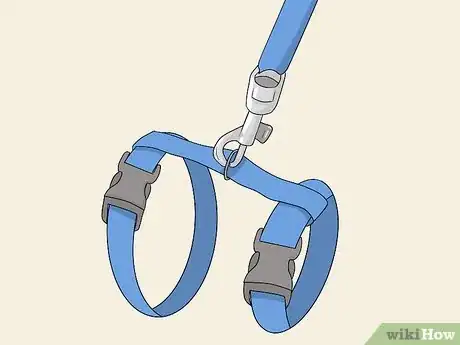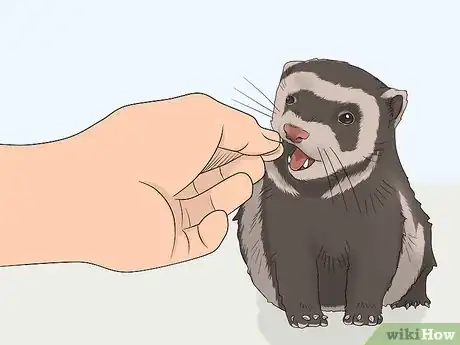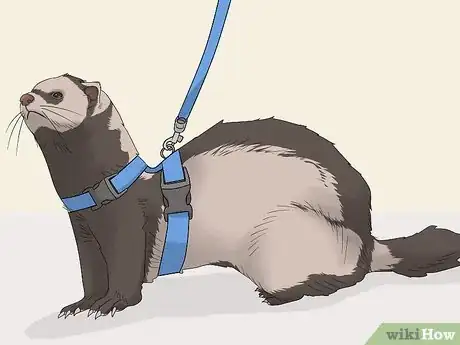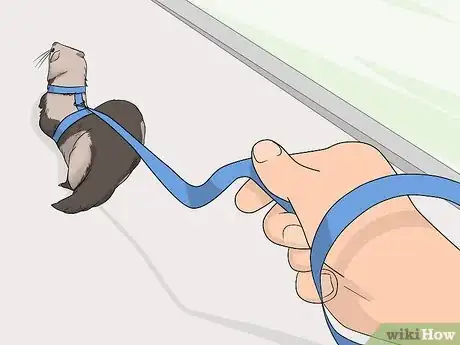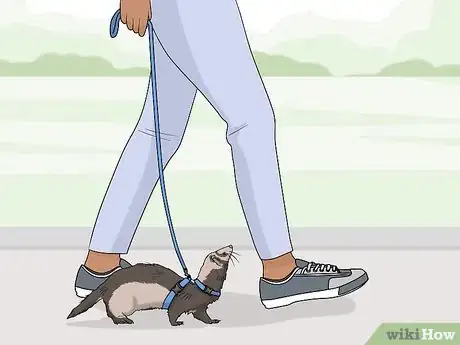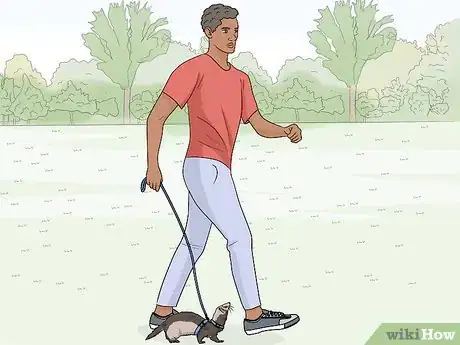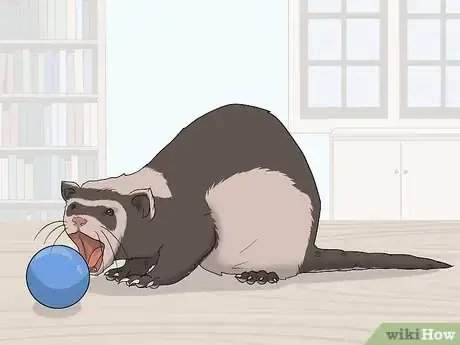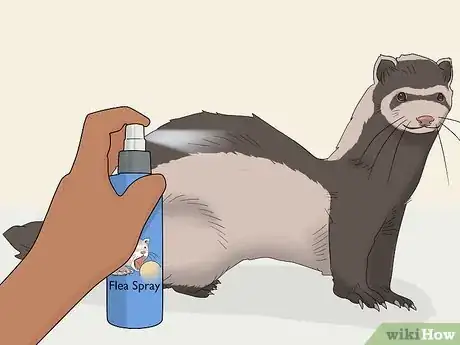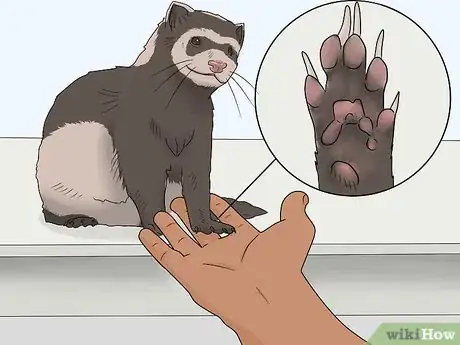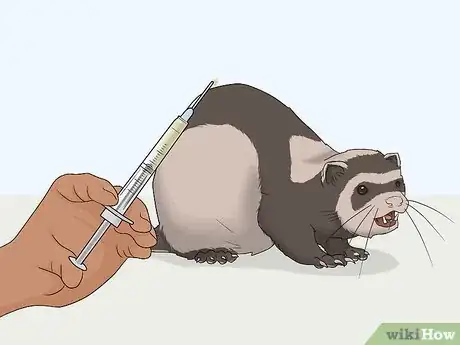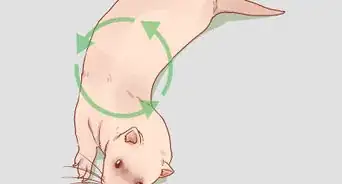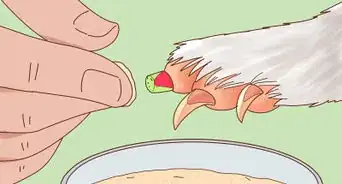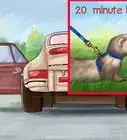This article was co-authored by Pippa Elliott, MRCVS. Dr. Elliott, BVMS, MRCVS is a veterinarian with over 30 years of experience in veterinary surgery and companion animal practice. She graduated from the University of Glasgow in 1987 with a degree in veterinary medicine and surgery. She has worked at the same animal clinic in her hometown for over 20 years.
There are 8 references cited in this article, which can be found at the bottom of the page.
This article has been viewed 61,936 times.
Going for a walk can be a great experience for both you and your ferret. Leash training your ferret will allow him to explore the outside world while still being safely in your control. Check your local animal control ordinances before you take your ferret outside. It is not permitted in some areas.
Steps
Getting Accustomed to the Harness and Leash
-
1Purchase a H-style harness. Visit your local pet store and purchase a H-style harness for ferrets. Do not buy a collar or a Figure-8 style harnesses. Your ferret could easily slip out of a collar, and the Figure-8 harness is often too loose on one side and too tight on the other.[1]
- The harness should be made of nylon and have plastic buckles.
- Metal buckles get too hot in the sun, and Velcro closures make it too easy for your ferret to escape.
-
2Put the harness on your ferret indoors. Place the harness on your ferret for a few minutes and give him a treat. Your ferret will probably not like the harness at first and may resist, pretend to fall, or try to run away from you.[2]
- Make sure the harness fits properly and is not too loose or too tight. You should be able to fit your little finger between the harness and your ferret.
- Slowly increase the amount of time your ferret wears the harness and give him a treat each time. Your ferret should be used to the harness in a few weeks.
- Let your ferret play while wearing his new harness. Give him a favorite toy, treat, or play a favorite game while wearing his harness.
Advertisement -
3Attach a leash to the harness. Once your ferret is comfortable with the harness, attach a ferret leash. Allow him to play with the leash attached, but do not hold the leash. Give your ferret a treat to reward his good behavior.[3]
- Always supervise your ferret when his leash is attached. You do not want it to get tangled around his neck or some other object.
- Gradually increase the time you leave the leash on. Move on to the next step once your ferret stops negatively reacting to wearing the leash.
-
4Hold the leash. Once your ferret gets used to the leash, hold the leash and let your ferret walk around. Allow your ferret to lead. Gently tug on the leash a little to teach your ferret about resistance. Always reward your ferret with a treat.[4]
- After a few training sessions, begin to direct your ferret using the leash. If he moves in a direction you do not like, gently tug the leash and guide him the desired direction. Reward him with a treat for following your lead.
- Never yank your ferret with the leash or pick him up by his leash.
Taking Your Ferret Outside
-
1Walk close to your home. Your first walk should be close to home. If possible, walk in a private, fenced yard.[5] The first walks should only last for a few minutes, and then you can build up to 15-20 minute walks.[6] Your ferret will be the leader for the most part. It is difficult to teach them to take direction like a dog.[7]
- Take treats and water with you on your walk. Ferrets can easily dehydrate.
- If your ferret is too scared to go outside, sit outside and allow your ferret to stay inside. Continue to hold the leash and be patient. Your ferret should be open to going outside after a few attempts.
-
2Walk further from home. Once your ferret is comfortable in your yard, you can take him for a walk in your neighborhood. He may feel more comfortable walking next to hedge lines.[8] Stay away from places where a lot of other animals are. You do not want your ferret to pick up any illnesses.[9]
- Your ferret will want to explore, but do not let him drink from any ponds or puddles.
- Don’t let other people touch your ferret when you are out.
-
3Allow your ferret to have fun. Your ferret will enjoy playing in a pile of leaves, dirt, or freshly cut grass. If your ferret is staying in your yard, you can set up some of these fun things for your ferret to get into. Your ferret will not walk in a straight line as you go down the sidewalk.[10]
- Try to only use the leash to keep your ferret from getting into danger such as going down drainpipes or engaging with other animals.
- Pick up your ferret immediately if a dog approaches.
Staying Safe
-
1Avoid extreme temperatures. Your ferret will not do well if the temperature is 80 degrees Fahrenheit or higher. If it is warm outside, try to stay in the shade. Take a water bottle with some ice in it so your ferret has something cool to drink. You can also fill a spray bottle with cold water and spray your ferret down.[11]
- Consider the temperature of the walking surface. Asphalt and cement heat up on warm days and bother his feet.
- Neither extreme cold nor extreme heat are good for your ferret. Keep him inside instead.
- If the temperature is below 40 degrees Fahrenheit, your ferret may get cold. If he begins to shiver, place him in your jacket and go home.
-
2Apply bug spray. Spray your ferret with a ferret safe flea and tick spray. These bugs carry diseases and/or parasites that are harmful for your ferret. Spray his entire body, and use a cotton swab to apply the spray to his ears and under his chin. Avoid spraying his eyes and nose.[12]
- Check your ferret for bugs before you bring him back inside.
- If you notice any bites, treat them with antibiotic cream or ointment.
- If your ferret has any swelling or redness from the bites, call your veterinarian.
-
3Check his feet. At the end of each walk, check his feet for any pebbles, stones, splinters, or broken toe nails.[13] Wash his feet after the walk if you need to. You can also carry alcohol wipes with you on your walk so you can immediately clean his feet if necessary.[14]
- Be extra careful if your ferret walks on gravel. There may be sharp stones or glass mixed in with the gravel.
-
4Vaccinate for distemper. Distemper is a fatal, airborne virus. Your ferret is much more likely to get distemper by going outside. He can pick it up from grass, weeds, trees, other animals, shrubs,and even you.[15]
- After the initial shot, your ferret will need to get an annual booster.
- You may also want to give your ferret the rabies vaccine. Talk to your veterinarian about the proper vaccines for your pet.
-
5Stay away from fertilizers. Fertilizers and weed killers are poisonous to your ferret. Do not take your ferret in any lawns that have signs from commercial lawn care companies. You will not always know if a lawn has been treated with fertilizers, but try to avoid them as much as you can.[16]
- Fertilizers are usually safe after drying for 24 hours.
- Also avoid any leaking car fluids such as oil, antifreeze, and windshield washer fluid.
References
- ↑ http://www.drsfostersmith.com/pic/article.cfm?aid=2064
- ↑ http://www.cypresskeep.com/Ferretfiles/Walk.htm
- ↑ http://www.cypresskeep.com/Ferretfiles/Walk.htm
- ↑ http://www.cypresskeep.com/Ferretfiles/Walk.htm
- ↑ http://www.ferret.org/pdfs/education/fitness.pdf
- ↑ http://www.cypresskeep.com/Ferretfiles/Walk.htm
- ↑ http://weaselwords.com/ferret-articles/outdoor-dangers/
- ↑ http://www.ferret.org/pdfs/education/fitness.pdf
- ↑ http://www.petplace.com/article/small-mammals/general/behavior-training-of-small-mammals/taking-your-ferret-for-a-hazard-free-walk
- ↑ http://www.cypresskeep.com/Ferretfiles/Walk.htm
- ↑ http://weaselwords.com/ferret-articles/outdoor-dangers/
- ↑ http://weaselwords.com/ferret-articles/outdoor-dangers/
- ↑ http://www.cypresskeep.com/Ferretfiles/Walk.htm
- ↑ http://weaselwords.com/ferret-articles/outdoor-dangers/
- ↑ http://www.ferretuniverse.com/health/distemper.asp
- ↑ http://weaselwords.com/ferret-articles/outdoor-dangers/
About This Article
To train your ferret to walk on a leash, start by purchasing an H-style harness and putting it on your ferret indoors for a few minutes at a time. Once your ferret is used to the harness, attach a leash, and let it play while you supervise to make sure the leash doesn't get wrapped around your pet or anything else. When you’re ready to go outside, stay in your yard or close to home and only go out for a few minutes. You can gradually work your way up to walks around the neighborhood, but make sure to keep your ferret away from other animals so it doesn't pick up any illnesses. For more tips from our Veterinary co-author, including how to keep your ferret safe during outdoor walks, keep reading!
